Toshiba 32TL838, 40TL838, 46TL838 User Manual

TL83* Digital
Series

English
Contents |
|
INSTALLING YOUR TV |
|
Safety Precautions ............................................................................. |
4 |
Installation and important information ..................................... |
5 |
The remote control ........................................................................... |
8 |
Inserting batteries and effective range ............................ |
8 |
CONNECTING YOUR TV |
|
Connecting external equipment .................................................. |
9 |
Connecting an HDMI® device ...................................................... |
10 |
To connect an HDMI device ............................................... |
10 |
Connecting a computer ................................................................ |
11 |
To connect a PC to the RGB/PC terminal ....................... |
11 |
To connect a PC to the HDMI terminal ........................... |
11 |
Connecting a home network ...................................................... |
12 |
To connect the TV to a home network - Wired ........... |
12 |
To connect the TV to a home network with an |
|
internet connection - Wireless ..................................... |
12 |
Controls and input connections ................................................. |
13 |
Switching on ............................................................................ |
13 |
Using the menu system ....................................................... |
13 |
Using the TV controls and connections ......................... |
13 |
SETTING UP YOUR TV |
|
Startup Application ......................................................................... |
14 |
Quick Setup .............................................................................. |
14 |
Ant/Cable In (if available) .................................................... |
15 |
Auto Tuning ............................................................................. |
16 |
ATV Manual Tuning ......................................................................... |
16 |
Tuning ........................................................................................ |
16 |
Skip .............................................................................................. |
18 |
Sorting positions .................................................................... |
18 |
DTV Manual Tuning ........................................................................ |
19 |
Manual Tuning ........................................................................ |
19 |
Manual Tuning for DVB-C ................................................... |
19 |
DTV Settings ...................................................................................... |
20 |
Channels ................................................................................... |
20 |
Location setting ...................................................................... |
20 |
Analogue switch-off ............................................................ |
20 |
CONTROLS AND FEATURES |
|
General controls ............................................................................... |
21 |
Quick Menu .............................................................................. |
21 |
Selecting channels ................................................................ |
21 |
The Time Display – analogue only ................................. |
21 |
Stereo and Bilingual transmissions ................................. |
21 |
Using 3D functions ......................................................................... |
22 |
Viewing 3D images ............................................................... |
22 |
Switching display mode or selecting 3D format ........ |
22 |
Setting the auto start mode .............................................. |
24 |
Setting the 3D PIN code ...................................................... |
24 |
Setting 3D Start Message .................................................... |
24 |
Setting 3D Lock ...................................................................... |
25 |
Setting 3D Timer Lock .......................................................... |
25 |
Setting Enable 3D Timer ..................................................... |
25 |
Displaying 3D Important Info ............................................ |
25 |
Switching left and right images ....................................... |
25 |
Sound controls ................................................................................. |
26 |
Volume controls and sound mute ................................... |
26 |
Dual ............................................................................................. |
26 |
Balance ...................................................................................... |
26 |
Bass, Treble .............................................................................. |
26 |
Voice Enhancement .............................................................. |
26 |
Dynamic Bass Boost .............................................................. |
26 |
Stable Sound® ......................................................................... |
26 |
Dynamic Range Control ...................................................... |
26 |
Audio Level Offset ................................................................. |
27 |
Headphone Settings ............................................................. |
27 |
Audio Description ................................................................. |
27 |
Widescreen viewing ....................................................................... |
28 |
Picture controls ................................................................................ |
30 |
Picture Mode ........................................................................... |
30 |
Picture preferences ............................................................... |
30 |
Reset ........................................................................................... |
30 |
ColourMaster ........................................................................... |
30 |
Base Colour Adjustment ..................................................... |
31 |
Colour Temperature ............................................................. |
31 |
Auto Brightness Sensor ....................................................... |
31 |
Active Backlight Control ...................................................... |
31 |
Black/White Level .................................................................. |
31 |
MPEG NR – Noise Reduction .............................................. |
31 |
DNR – Digital Noise Reduction ......................................... |
31 |
Active Vision ............................................................................ |
32 |
Resetting the advanced picture settings ...................... |
32 |
Automatic Format (Widescreen) ...................................... |
32 |
4:3 Stretch ................................................................................ |
32 |
Blue Screen .............................................................................. |
32 |
Picture Position ...................................................................... |
32 |
Picture still ................................................................................ |
32 |
Using your home network ........................................................... |
33 |
Setting up the Network ................................................................. |
34 |
Wireless Setup ........................................................................ |
34 |
Advanced Network Setup .................................................. |
36 |
DNS Setup ................................................................................ |
37 |
Network Connection Test ................................................... |
37 |
Using the software keyboard ............................................ |
38 |
2

Using Toshiba Places ...................................................................... |
38 |
Using YouTube™ .............................................................................. |
39 |
Using Hybrid TV Standard (if available) ................................... |
39 |
Using the Media Player .................................................................. |
40 |
Basic operation ....................................................................... |
40 |
Viewing photo files |
|
(on a DLNA CERTIFIED™ Server or USB device) ....... |
41 |
Viewing movie files |
|
(on a DLNA CERTIFIED™ Server or USB device) ....... |
43 |
Playing music files |
|
(on a DLNA CERTIFIED™ Server or USB device) ....... |
45 |
Other features ................................................................................... |
46 |
Panel Lock ................................................................................. |
46 |
The timers ........................................................................................... |
47 |
Programme Timers – digital only ................................... |
47 |
On Timer .................................................................................... |
47 |
Sleep Timer .............................................................................. |
48 |
Energy Saving Settings .................................................................. |
48 |
Automatic Power Down ...................................................... |
48 |
No Signal Power Down ........................................................ |
48 |
Digital on-screen information and Programme Guide ...... |
49 |
Information .............................................................................. |
49 |
Guide .......................................................................................... |
50 |
Genre selection/searching .................................................. |
50 |
Digital settings – parental control ............................................ |
51 |
Parental PIN Setup ................................................................. |
51 |
Parental Setup ......................................................................... |
51 |
Network Lock .......................................................................... |
51 |
Digital settings – Channel Options .......................................... |
52 |
Selecting favourite channels ............................................. |
52 |
Favourite Channel Lists ....................................................... |
52 |
Skip channels ........................................................................... |
52 |
Locking channels ................................................................... |
52 |
Digital settings – other settings ................................................ |
53 |
Subtitles ..................................................................................... |
53 |
Audio languages .................................................................... |
53 |
Common Interface ................................................................ |
53 |
Software Upgrade and Licences ................................................ |
54 |
Searching for New Software .............................................. |
54 |
Network Upgrade .................................................................. |
54 |
Software Licences .................................................................. |
54 |
System Information and Reset TV .............................................. |
54 |
System Information ............................................................... |
54 |
Reset TV ..................................................................................... |
54 |
PC Settings ......................................................................................... |
55 |
Horizontal and Vertical Position ....................................... |
55 |
Clock Phase .............................................................................. |
55 |
Sampling Clock ....................................................................... |
55 |
Reset ........................................................................................... |
55 |
Input selection and AV connections ......................................... |
56 |
Input selection ........................................................................ |
56 |
External input skip ................................................................. |
56 |
Labeling video input sources ............................................ |
57 |
Digital Audio Output ............................................................ |
57 |
TEXT SERVICES |
|
Text services ...................................................................................... |
58 |
Selecting modes .................................................................... |
58 |
Text information .................................................................... |
58 |
Navigating pages using Auto ............................................ |
58 |
Navigating pages using LIST ............................................. |
58 |
Control buttons ...................................................................... |
59 |
PROBLEM SOLVING |
|
Questions and Answers ............................................................... |
60 |
INFORMATION |
|
License Information ........................................................................ |
63 |
Information ........................................................................................ |
65 |
Specifications and accessories ................................................... |
71 |
English
3

English
INSTALLING YOUR TV
Safety Precautions
This equipment has been designed and manufactured to meet international safety standards but, like any electrical equipment, care must be taken to obtain the best results and for safety to be assured. Please read the points below for your own safety. They are of a general nature, intended to help with all electronic consumer products, and some points may not apply to the goods you have just purchased.
Air Circulation
Leave more than 10cm clearance around the television to allow adequate ventilation. This will prevent overheating and possible damage to the television. Dusty places should also be avoided.
Heat Damage
Damage may occur if the television is left in direct sunlight or near a heater. Avoid places subject to extremely high temperatures or humidity. Place in a location where the temperature remains between 5°C min. and 35°C max.
Mains Supply
The mains supply required for this equipment is 220240v AC 50/60Hz. Never connect to a DC supply or any other power source. DO ensure that the television is not standing on the mains lead. Use only the supplied lead.
DO NOT cut off the mains plug from this equipment, this incorporates a special Radio Interference Filter, the removal of which will impair its performance.
IF IN DOUBT, PLEASE CONSULT A COMPETENT ELECTRICIAN.
DO NOT REMOVE ANY FIXED COVERS AS THIS WILL EXPOSE DANGEROUS AND ‘LIVE’ PARTS.
THE MAINS PLUG IS USED AS A DISCONNECTING DEVICE AND THEREFORE SHOULD BE READILY OPERABLE.
Do not
DO NOT obstruct the ventilation openings of the equipment with items such as newspapers, tablecloths, curtains, etc. Overheating will cause damage and shorten the life of the equipment.
DO NOT allow electrical equipment to be exposed to dripping or splashing or objects filled with liquids, such as vases, to be placed on the equipment.
DO NOT place hot objects or naked flame sources, such as lighted candles or nightlights on, or close to equipment. High temperatures can melt plastic and lead to fires.
WARNING: To prevent the spread of fire, keep candles or other open flames away from this product at all times.
DO NOT use makeshift stands and NEVER fix legs with wood screws. To ensure complete safety, always fit the manufacturer’s approved stand, bracket or legs with the fixings provided according to the instructions.
DO NOT leave equipment switched on when it is unattended, unless it is specifically stated that it is designed for unattended operation or has a standby mode. Switch off by withdrawing the plug, and make sure your family knows how to do this. Special arrangements may need to be made for people with disabilities.
Do
DO read the operating instructions before you attempt to use the equipment.
DO ensure that all electrical connections (including the mains plug, extension leads and interconnections between pieces of equipment) are properly made and in accordance with the manufacturers’ instructions. Switch off and withdraw the mains plug before making or changing connections.
DO consult your dealer if you are ever in doubt about the installation, operation or safety of your equipment.
WARNING: To prevent injury, this apparatus must be securely attached to the floor/wall in accordance with the installation instructions. See page 5.
DO be careful with glass panels or doors on equipment.
DO NOT continue to operate the equipment if you are in any doubt about it working normally, or it is damaged in any way – switch off, withdraw the mains plug and consult your dealer.
WARNING – excessive sound pressure from earphones or headphones can cause hearing loss.
ABOVE ALL - NEVER let anyone, especially children, push or hit the screen and cabinet back, or push anything into holes, slots or any other openings in the case. These actions will damage screen or internal parts.
NEVER guess or take chances with electrical equipment of any kind - it is better to be safe than sorry.
4
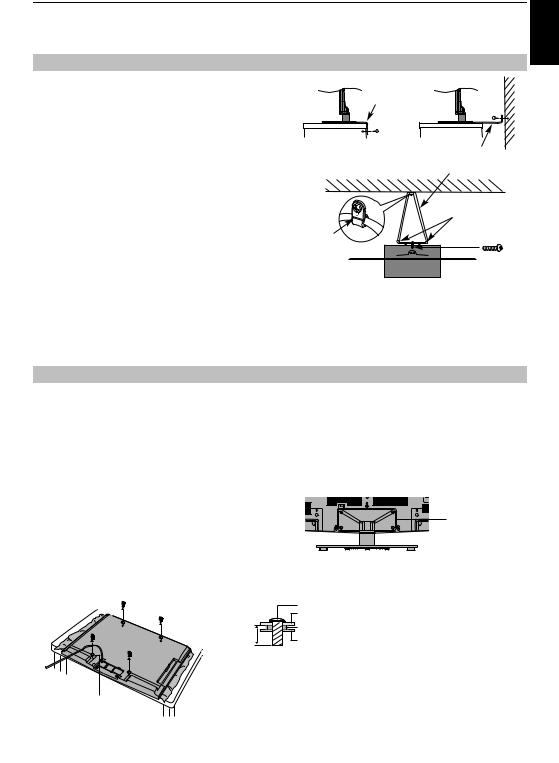
INSTALLING YOUR TV
Installation and important information
Where to install
Locate the television away from direct sunlight and strong lights. Soft, indirect lighting is recommended for comfortable viewing. Use curtains or blinds to prevent direct sunlight falling on the screen.
Place the TV on a stable, level surface that can support the weight of the TV. In order to prevent injury and maintain stability of this apparatus, secure the TV to the level surface using the strap if fitted, or to a wall using a sturdy tie to the P clips provided. Otherwise secure the TV on the level surface using the supplied mounting screw.
The LCD display panels are manufactured using an extremely high level of precision technology; however, sometimes some parts of the screen may be missing picture elements or have luminous spots. This is not a sign of a malfunction.
Make sure the television is located in a position where it cannot be pushed or hit by objects, as pressure will break or damage the screen. Also, please be certain that small items cannot be inserted into slots or openings in the case.
Fixing strap
Fixing strap
Sturdy tie (as short as possible)
Stand clip
‘P’ Clip
 Screw
Screw
(supplied)
Stand style is dependent on model
Cleaning the screen and cabinet…
Turn off the power, and clean the screen and cabinet with a soft, dry cloth. The enclosed cleaning cloth is for cabinet cleaning. We recommend that you do not use any proprietary polishes or solvents on the screen or cabinet as this may cause damage.
When using a Wall Bracket
Please use a wall bracket appropriate for the size and weight of the LCD TV.
•Two people are required for installation.
•To install a wall-mount from another manufacturer, use the SPACERS (supplied).
1Unplug and remove any cables and/or other component connectors from the rear of the TV.
2Carefully lay the front of the unit face down on a flat, cushioned surface such as a quilt or blanket.
3Follow the instructions provided with your wall bracket. Before proceeding, make sure the appropriate bracket(s) are attached to the wall and the back of the TV as described in the instructions provided with the wall bracket.
4Make sure to place the spacers supplied between the bracket and the back of the TV.
5Always use the screws supplied or recommended by the wall mount manufacturer.
Removing the Pedestal Stand:
1Carefully lay the front of the unit face down on a flat, cushioned surface such as a quilt or blanket. Leave the stand protruding over the edge of the surface.
NOTE: Extreme care should always be used when removing the pedestal stand to avoid damage to the LCD panel.
2Remove the four screws.
Four screws
3Once you have removed all four screws holding the pedestal stand in place, remove the pedestal stand from the TV by sliding the pedestal stand away from the TV.
|
Screw |
|
|
Wall bracket |
|
28–32mm |
Spacer (supplied) |
|
TV back panel |
||
|
||
M6 |
(32TL) |
|
M8 |
(40TL and 46TL) |
|
CAUTION: The diameter and length of the screws |
Place four spacers (supplied). |
differ depending on wall bracket model. Use of screws |
other than the screws specified may result in internal |
|
|
damage to the TV set or cause it to fall, etc. |
English
5

English
INSTALLING YOUR TV
When using the 3D glasses (not supplied)
Cautions on watching 3D images
•Some viewers may experience a seizure or blackout when exposed to certain flashing images or lights contained in certain 3D television pictures or video games.
Anyone who has had a seizure, loss of awareness, or other symptoms linked to an epileptic condition, or has a family history of epilepsy, should contact a health care provider before using the 3D function.
•Avoid use of the 3D function when under the influence of alcohol.
•If you are ill or feel ill, you should refrain from viewing 3D images, and consult your health care provider as may be appropriate.
•If you experience any of the following symptoms when viewing 3D video images, stop viewing and contact your health care provider:
Convulsions, eye or muscle twitching, loss of awareness, altered vision, involuntary movements, disorientation, eye strain, nausea/vomiting, dizziness, headaches.
•If you feel eye fatigue or other discomfort from viewing 3D video images, remove the 3D glasses and discontinue use until the condition is eliminated.
•Viewing in 3D may cause dizziness and/or disorientation for some viewers.
Therefore, to avoid injury do not place your TV near open stairwells, balconies, or wires.
Also do not sit near objects that could be broken if accidentally hit.
•When viewing 3D images, always wear 3D glasses.
Watching 3D images without 3D glasses may cause eye strain.
Use specified 3D glasses.
•When watching 3D images, do not wear 3D glasses at an angle and do not lie down.
If you watch while lying down or with the glasses tilted, the 3D effect is lost and it may cause eye strain.
•It is recommended that the viewer's eyes and 3D glasses are level with the screen.
•If you have prescription eye glasses or contact lenses, wear the 3D glasses over them.
Watching 3D images without appropriate eyewear may cause eye strain.
•If 3D images often appear in double or if you cannot see the images in 3D, stop viewing.
Continuous viewing may cause eye strain.
•Due to the possible impact on vision development, viewers of 3D video images should be age 6 or above.
Children and teenagers may be more susceptible to health issues associated with viewing in 3D and should be closely supervised to avoid prolonged viewing without rest.
•Watching TV while sitting too close to the screen for an extended period of time may cause eye strain.
The ideal viewing distance should be at least three times the screen height.
Notes on IR communication
•Do not block the IR sensor for 3D glasses on the TV by placing objects in front of it.
•Do not cover the IR sensor on the 3D glasses with stickers or labels.
•Keep the IR sensor on the 3D glasses clean.
•The use of 3D glasses could interfere with other IR communication devices. Other IR communication devices may cause the 3D glasses not to work correctly. Use the TV and 3D glasses in a place where they will not interfere with other devices or products.
Notes on watching the TV
•3D effect and image quality may vary depending upon content quality and display device capability/ functionality/settings.
•If you use any device, such as a mobile phone or mobile wireless device, near the 3D glasses, the 3D glasses may not work correctly.
•Use the product in the following temperature range; otherwise, the quality of the 3D image or the reliability of the product cannot be guaranteed.
-3D glasses: 0°C - 40°C (32°F - 104°F)
-TV: 0°C - 35°C (32°F - 95°F)
•If you use a fluorescent light, it may flicker depending on the frequency of the light. In this case, reduce the brightness of the fluorescent light, or use another light. (It is not recommended to watch the TV in a dark room, especially for children.)
•Wear the 3D glasses properly, otherwise you may not see the correct 3D image.
•When not viewing 3D images on this unit, take off the 3D glasses; otherwise, it may be difficult to see the display on other products such as PC, digital clock or calculator, etc.
About the connecting cable
•Use a high-speed and high-quality HDMI cable when you connect a device such as 3D compatible BD player or PC to the TV. When you use a standard HDMI cable, 3D images may not be shown.
If the 3D PIN number has been forgotten:
Use the Master PIN code of 1276, and then change to a number of your choice. Select 3D PIN from the
PREFERENCES / 3D Setup menu to enter PIN.
6

INSTALLING YOUR TV
Please take note
The digital reception function of this television is only effective in the countries listed in the “Country” section of the “SETUP” menu. Depending on country/area, some of this television's functions may not be available. Reception of future additional or modified services can not be guaranteed with this television.
If stationary images generated by 4:3 broadcasts, text services, channel identification logos, computer displays, video games, on-screen menus, etc. are left on the television screen for any length of time, they could become conspicuous. It is always advisable to reduce both the brightness and contrast settings.
Very long, continuous use of the 4:3 picture on a 16:9 screen may result in some retention of the image at the 4:3 outlines. This is not a defect of the LCD TV and is not covered under the manufacturer’s warranty. Regular use of other size modes (e.g.: Super Live) will prevent permanent retention.
EXCLUSION CLAUSE
Toshiba shall under no circumstances be liable for loss and/or damage to the product caused by:
i)Fire;
ii)Earthquake;
iii)Accidental damage;
iv)Intentional misuse of the product;
v)Use of the product in improper conditions;
vi)Loss and/or damage caused to the product whilst in the possession of a third party;
vii)Any damage or loss caused as a result of the owner’s failure and/or neglect to follow the instructions set out in the owner’s manual;
viii)Any loss or damage caused directly as a result of misuse or malfunction of the product when used simultaneously with associated equipment;
Furthermore, under no circumstances shall Toshiba be liable for any consequential loss and/or damage including but not limited to the following: loss of profit, interruption of business, the loss of recorded data whether caused during normal operation or misuse of the product.
English
7
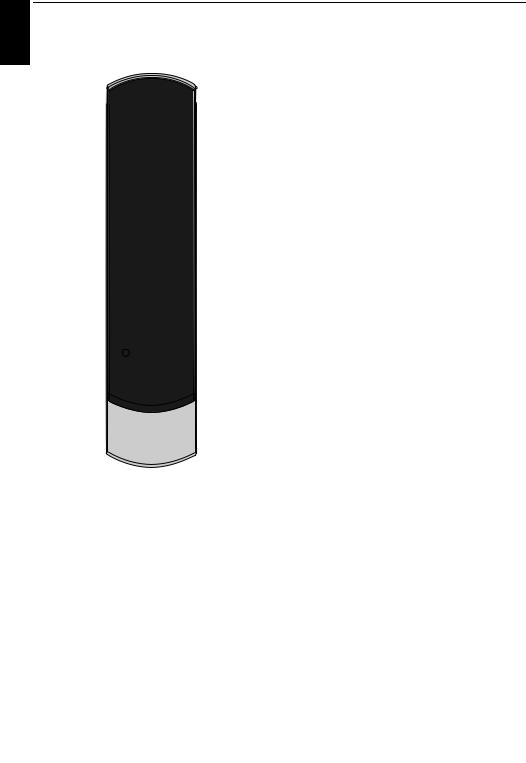
English
INSTALLING YOUR TV
The remote control |
|
16 |
To access the “TOSHIBA PLACES” Top Page |
||||
|
|
When network is not connected, an error message will be |
|||||
|
|
|
|||||
Simple at-a-glance reference of your remote control. |
|
displayed. |
|
|
|||
17 |
To access Media Player Menu |
|
|||||
1 |
|
|
|||||
3 |
18 |
To call up text services |
|
|
|||
2 |
|
|
|||||
19 |
To access the analogue or digital Channel List |
||||||
5 |
6 |
||||||
20 |
On-screen Menus |
|
|
||||
4 |
7 |
21 |
To display the digital on-screen Programme Guide |
||||
|
|
||||||
8 |
|
22 |
|
To page up, down, left or right |
|||
|
23 When using menus, the arrows move the cursor on the screen |
||||||
|
|
||||||
|
10 |
|
up, down, left or right. Press OK to confirm your selection |
||||
9 |
24 |
To return to previous Menu |
|
|
|||
12 |
|
|
|||||
|
25 |
To exit menus |
|
|
|||
11 |
13 |
|
|
||||
26 |
When in TV mode: |
When in Text mode: |
|||||
15 |
|||||||
|
|
r |
Picture still |
A |
To reveal concealed |
||
|
14 |
|
|||||
16 |
|
|
text |
||||
19 |
|
DAnalogue time |
B |
To hold a wanted |
|||
17 |
18 |
|
|
display |
|
page |
|
20 |
|
|
|
C |
|||
21 |
|
|
|
To enlarge text |
|||
22 |
|
|
|
||||
23 |
|
|
|
|
display size |
||
24 |
|
|
|
DTo temporarily |
|||
25 |
|
|
|
|
erase the text |
||
|
|
|
|
|
|
screen |
|
|
26 |
|
When using Programme |
During Playback: |
|||
|
|
|
Guide: |
c |
To PLAY |
||
|
27 |
|
Z |
–24 hours |
v |
To STOP |
|
|
|
z |
+24 hours |
W/w To PAUSE/STEP |
|||
|
|
|
CC |
–1 page |
Z |
To SKIP-BACK |
|
|
|
|
cc |
+1 page |
CC |
To REWIND |
|
|
|
|
|
|
cc |
To FAST FORWARD |
|
|
|
|
|
|
z |
To SKIP-FORWARD |
|
|
|
27 |
Colour buttons: Text and interactive service control buttons |
||||
1For On/Standby mode
2To select external input sources
3To select TV Mode
4To switch between 2D and 3D modes
5Widescreen viewing
6 sStereo/bilingual transmissions
7Digital Subtitles
8Number buttons
9Switch the Audio Description On/Off
10To return to previous channel
11To alter the TV volume
12To display on-screen information
To access the index page in Text mode
13To mute the TV sound
14To access Quick Menu
15To change programme positions To change TEXT pages
Inserting batteries and effective range
Remove the back cover to reveal the battery compartment and make sure the batteries are inserted the proper way. Suitable battery types for this remote are AA, IEC R6 1.5V.
Do not combine a used, old battery with a new one or mix
battery types. Remove dead batteries immediately to prevent acid from leaking into the battery compartment. Dispose of them in accordance with instructions on page 64 of this manual.
Warning: Batteries must not be exposed to excessive heat such as sunshine, fire or the like.
The performance of the remote control will deteriorate beyond a distance of five metres or outside an angle of 30 degrees from the centre of the television. If the operating range becomes reduced, the batteries may need replacing.
8
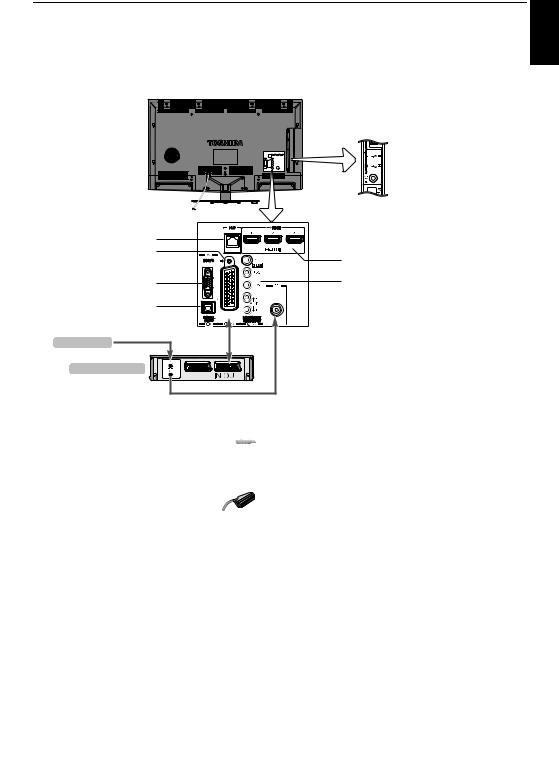
CONNECTING YOUR TV
Connecting external equipment
Before connecting any external equipment, turn off all main power switches. If there is no switch, remove the mains plug from the wall socket.
ILLUSTRATION SHOWS 40TL838.


 HDMI 4 INPUT
HDMI 4 INPUT
 HEADPHONE jack
HEADPHONE jack
Power cord 

English
LAN port |
|
SCART (EXT 1) |
HDMI 1/2/3 INPUTS |
|
|
RGB/PC INPUT |
COMPONENT VIDEO/AUDIO |
|
VIDEO/AUDIO INPUT (Y/L/R) |
DIGITAL AUDIO OUT PUT |
(EXT 2) |
(OPTICAL) |
|
Aerial Cable |
|
Media Recorder |
|
Aerial cables:. . . . . . . . . . . . . . . . . . . . . . . . . . . . . . . . . . 



Connect the aerial to the socket on the rear of the television. If you use a decoder and/or a media recorder, it is essential that the aerial cable is connected through the decoder and/or through the media recorder to the television.
SCART leads: . . . . . . . . . . . . . . . . . . . . . . . . . . . . . . . . . .
Connect the media recorder IN/OUT socket to the television. Connect the decoder TV socket to the television.
Before running Auto Tuning, put your decoder and media recorder to Standby.
The phono sockets alongside the COMPONENT VIDEO INPUT sockets will accept L and R audio signals.
When connecting the VIDEO/AUDIO devices, connect those cables to Y/L/R sockets.
The Digital Audio Output socket enables the connection of a suitable surround sound system.
NOTE: This output is always active.
HDMI® (High-Definition Multimedia Interface) is for use with a DVD decoder or electrical equipment with digital audio and video output. For acceptable video or PC signal formats through the HDMI terminals, see page 66.
NOTE: Although this television is able to connect to HDMI equipment, it is possible that some equipment may not operate correctly.
LAN port is used to connect the TV to your home network. This TV can play digital content stored on a DLNA CERTIFIED™ product with server function.
A wide variety of external equipment can be connected to the back of the television; therefore, the relevant owner’s manuals for all additional equipment must be referred to for exact instructions.
If the television automatically switches over to monitor external equipment, return to normal television by pressing the desired programme position button. To recall external equipment, press p/ oto select between DTV, EXT 1,
EXT 2, HDMI 1, HDMI 2, HDMI 3, HDMI 4, PC or ATV.
When the external input mode is selected while viewing DTV mode, the SCART socket does not output video/audio signals.
9
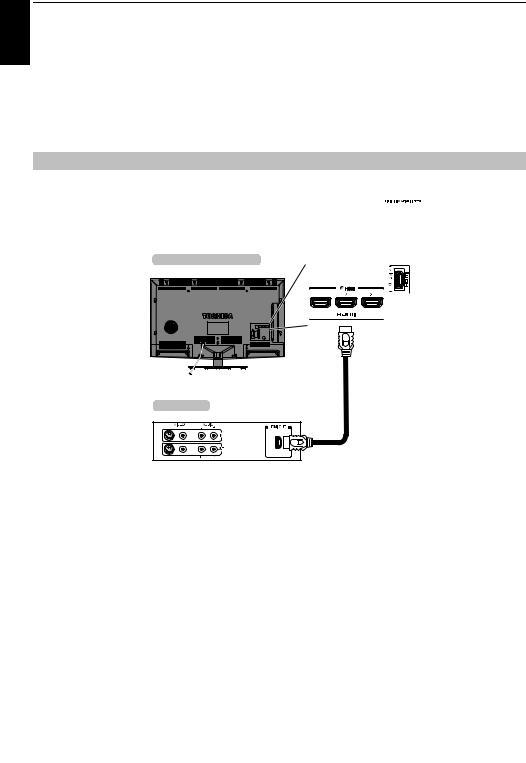
English
CONNECTING YOUR TV
Connecting an HDMI® device
The HDMI input on your television receives digital audio and uncompressed digital video from an HDMI source device.
This input is designed to accept HDCP (High-Bandwidth Digital-Content Protection) programme material in digital form from EIA/ CEA-861-D–compliant consumer electronic devices (such as a set-top box or DVD player with HDMI output). For acceptable video signal formats, see page 66.
NOTE: Supported Audio format: Linear PCM, Dolby Digital (AC-3), sampling rate 32/44.1/48kHz.
To connect an HDMI device
Connect an HDMI cable (type A connector) to the HDMI terminal.
For proper operation, it is recommended that you use an HDMI cable with the HDMI Logo ( 

 ).
).
•If your HDMI connection is capable of 1080p and/or your television is capable of refresh rates greater than 50Hz, you will need a Category 2 cable. Conventional HDMI/DVI cable may not work properly with this model.
•HDMI cable transfers both video and audio. Separate analogue audio cables are not required (see illustration).
the back of your television
HDMI cable 
HDMI device
To view the HDMI device video, press the obutton to select HDMI 1, HDMI 2, HDMI 3 or HDMI 4 mode.
10
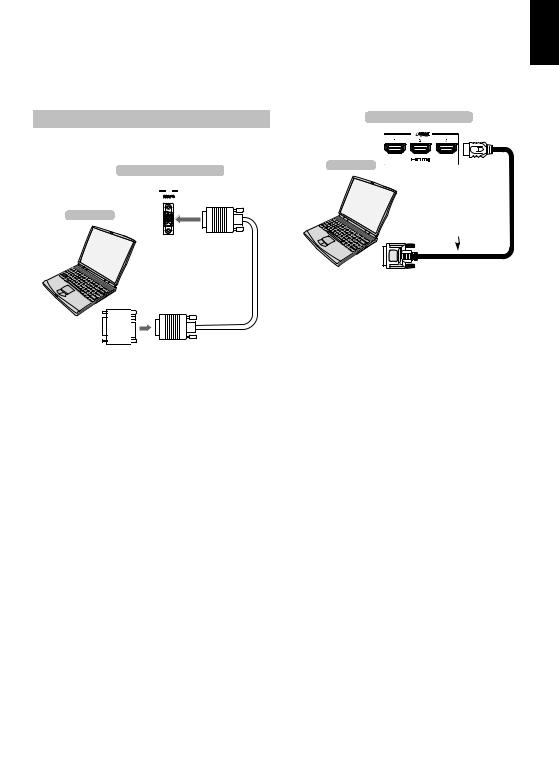
|
CONNECTING YOUR TV |
|
Connecting a computer |
|
|
To connect a PC to the HDMI terminal |
||
With either an RGB/PC or an HDMI connection, you can watch your computer’s display on the television.
To connect a PC to the RGB/PC terminal
When connecting a PC to the RGB/PC terminal on the television, use an analogue RGB (15-pin) computer cable.
the back of your television
Mini D-sub
15 pin connector
Computer
RGB PC cable (not  supplied)
supplied)
Conversion adaptor if required
(not supplied)
To use a PC, set the monitor output resolution on the PC before connecting it to the television. For acceptable PC signal formats, see page 65.
To display the optimum picture, use the PC setting feature (see page 55).
NOTE:
•Some PC models cannot be connected to this television.
•An adaptor is not needed for computers with a compatible mini D-sub15-pin terminal.
•Depending on the DVD’s title and the specifications of the PC on which you are playing the DVD-Video, some scenes may be skipped or you may not be able to pause during multi-angle scenes.
•A band may appear at the edges of the screen or parts of the picture may be obscured. This is due to scaling of the picture by the set, it is not a malfunction.
•When PC input mode is selected, some of the television’s features will be unavailable e.g. Colour System in the
SETUP menu.
•Some PC models may output unique signals that the television may be unable to detect (see page 65).
•If connecting a certain PC model with a unique PC signal, the PC signal may not be detected correctly.
When connecting a PC to the HDMI terminal on the television, use an HDMI-to-DVI adaptor cable.
If connecting a PC with an HDMI terminal, use an HDMI cable (type A connector).
the back of your television
Computer
HDMI-to-DVI adaptor cable
For acceptable PC and video signal formats, see page 66.
NOTE:
•The edges of the images may be hidden.
•If connecting a certain PC model with a unique PC signal, the PC signal may not be detected correctly.
English
11
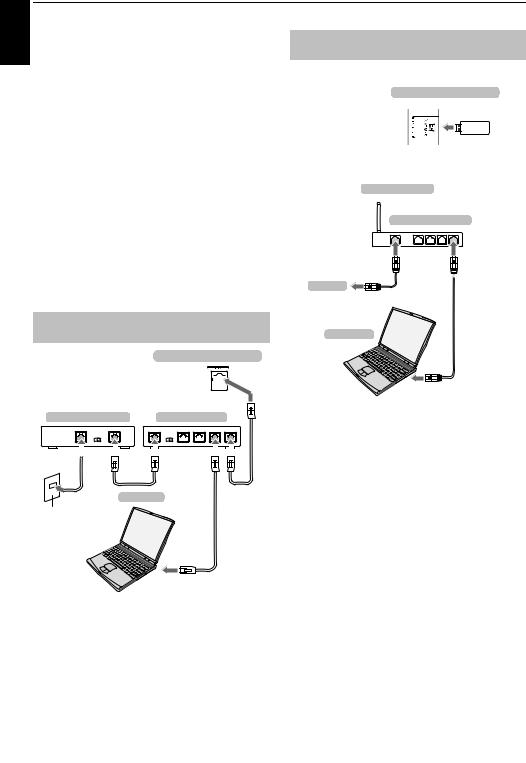
English
CONNECTING YOUR TV
Connecting a home network
The LAN port allows your Toshiba TV to connect to your home network. You can use this revolutionary home entertainment networking system to access photo, video and audio files that are stored on a DLNA CERTIFIED™ server and play/display them on your TV.
NOTE:
•If you connect to a shared network outside your home, it is advisable to use a router. Always use DLNA CERTIFIED™ products in private network environments. Connect this TV to the same router as other DLNA CERTIFIED™ products (server).
•If you use a hub or switch to connect the TV to your home network, you may not be able to use the automatic setup and will have to manually set up the network address. See page 36.
•If you use a router with built-in DHCP functionality, use the automatic setup. Manual setup may not work.
•If you connect the TV and PC directly, use a crossover LAN cable.
To connect the TV to a home network - Wired
To connect the TV to a home network with an internet connection - Wireless
Please refer to “Wireless Setup” section on page 34.
the back of your television
TOSHIBA Dual Band WLAN adaptor
Access point (AP)
Wireless LAN router
Modem
Computer
the back of your television
|
|
|
|
|
|
|
|
|
|
|
|
|
|
|
|
|
|
|
|
|
|
|
|
|
|
|
|
|
|
|
|
|
|
|
|
|
|
|
|
|
|
|
|
|
|
|
|
|
|
|
|
|
|
|
|
|
|
|
|
|
|
|
|
|
|
|
|
|
|
|
|
|
|
|
|
|
|
|
|
|
|
|
|
|
|
|
|
|
|
|
|
|
|
|
|
|
|
|
|
|
|
|
|
|
|
|
|
|
|
|
|
Modem (if available) |
|
|
|
Router with Hub |
|
|
|
|
|
|
|||||||||||||||||
|
|
|
|
|
|
|
|
|
|||||||||||||||||||
|
|
|
|
|
|
|
|
|
|||||||||||||||||||
|
|
|
|
|
|
|
|
|
|
|
|
|
|
|
|
|
|
|
|
|
|
|
|
|
|
|
|
|
|
|
|
|
|
|
|
|
|
|
|
|
|
|
|
|
|
|
|
|
|
|
|
|
|
|
|
|
|
|
|
|
|
|
|
|
|
|
|
|
|
|
|
|
|
|
|
|
|
|
|
|
|
|
|
|
|
|
|
|
|
|
|
|
|
|
|
|
|
|
|
|
|
|
|
|
|
|
|
|
|
|
|
|
|
|
|
|
|
|
|
|
|
|
|
|
|
|
|
|
|
|
|
|
|
|
|
|
|
|
|
[1] [2]
[2] [3]
Server PC
Cable or Phone jack
[2]
How to use this Dual Band Wireless LAN Adaptor
•If this device is going to be operated in the frequency range of 5.15 GHz to 5.35 GHz, it is restricted to indoor use.
•If this device is going to be operated for 802.11 b/g/n function in the frequency range of 2.454 GHz to 2.4835 GHz in France, it is restricted to indoor use.
•A general authorization is required for using this device outdoors or in public places in Italy.
•This device is NOT ALLOWED to be used in the geographical area within a radius of 20km from the centre of Ny-Alesund in Norway.
[1]Coaxial or telephone cable (depending on your modem type)
[2]Standard LAN cable
[3]Do NOT connect a phone jack directly to the TV’s LAN port.
12
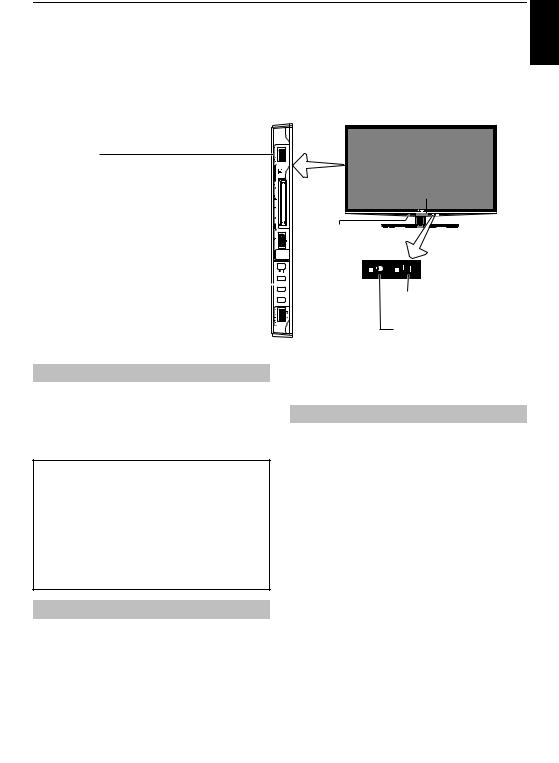
CONNECTING YOUR TV
Controls and input connections
A wide variety of external equipment can be connected to the input sockets on the side of the television.
While all the necessary adjustments and controls for the television are made using the remote control, the buttons on the television may be used for some functions.
English
ILLUSTRATION SHOWS 40TL838.
USB 1 port
Media Player
COMMON INTERFACE  The Common Interface is for a Conditional Access
The Common Interface is for a Conditional Access  Module (CAM).
Module (CAM).  Contact a service provider.
Contact a service provider. 
 The software updating of CI Plus CAM may be
The software updating of CI Plus CAM may be 


 automatically executed. At this time, your
automatically executed. At this time, your 


 Recording/Reminder programming will be canceled.
Recording/Reminder programming will be canceled. 

Control panel 

p / o
USB 2 port  Media Player/Wireless LAN adaptor ready for a home network
Media Player/Wireless LAN adaptor ready for a home network
Switching on
If the RED LED is not lit, check that the mains plug is connected to the power supply and press 1on the remote control; it may take a few moments. The GREEN LED will be lit.
To put the television into Standby, press 1on the remote control. To view the television, press 1again. The picture may take a few seconds to appear.
For energy saving:
We recommend that you use the television with the factory settings. The factory settings are for energy saving. Unplugging the mains plug will cut energy use to zero for all televisions. This is recommended when the television is not being used for a long time, e.g. when on holiday. Reducing the brightness of the screen will reduce energy use. Energy efficiency cuts energy consumption and thus saves money by reducing electricity bills.
NOTE: Putting the television into standby mode will reduce energy consumption, but will still draw some power.
Using the menu system
Press MENU on the remote control to display the menu.
The menu appears as a list of five topics. As each symbol is selected by pressing Cor con the remote control, its respective options will appear below.
NOTE: The same menu is displayed in DTV (Digital TV) and ATV (Analogue TV) modes; however, where some items are not available in a mode, they will appear grayed out.
3D IR
Ambient
Light Sensor
RED LED – Standby
GREEN LED – Power on
ORANGE LED – Programme timer set (digital only)
To use the option, press Band bon the remote control to move up and down and press Cor cto select your desired setting.
Using the TV controls and connections
•To turn on or off the TV, press !.
•To alter the volume, press + or – .
+ and – buttons operate as volume up/down as default.
•To alter the programme position, press p/ oonce and press uor U.
•To select an external input, press and hold p/ ountil the Inputs window appears, and then press uor Uto select the appropriate input source.
The Media Player feature provides access to photo, movie and music files stored on a USB storage device that is connected via the USB 1 or USB 2 port or on a network device.
NOTE: The USB socket has limited functionality and Toshiba can take no responsibility for damage to other connected equipment.
The USB 2 socket has to be used with the “TOSHIBA Dual Band WLAN Adaptor WLM-20U2” in order to access a wireless network.
You must use the TOSHIBA Wireless LAN device to ensure correct operation of this feature. This feature is available only when the “TOSHIBA Dual Band WLAN Adaptor“ is used.
Please always refer to the owner’s manual of the equipment to be connected for full details.
NOTE: Interactive video games that involve shooting a “gun” at an on-screen target may not work with this TV.
13
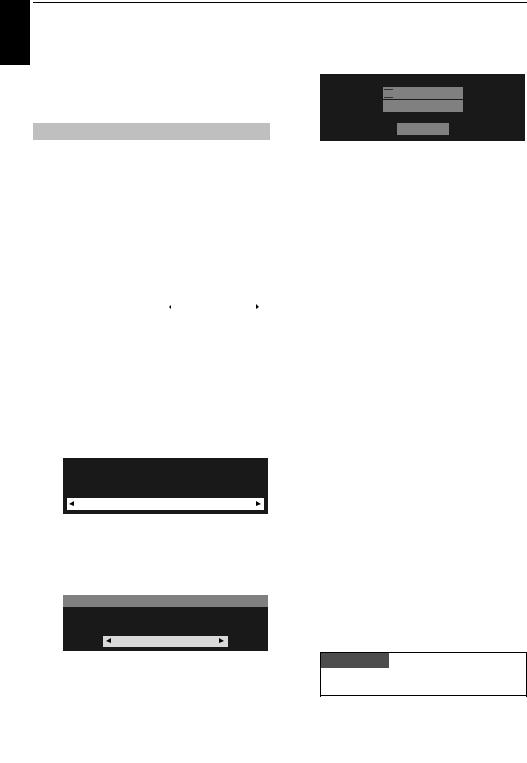
English
SETTING UP YOUR TV
Startup Application
Before switching on the TV, make sure your decoder/media recorder, if applicable, is in standby. To set up the television, use the buttons on the remote control as detailed on page 8.
Quick Setup
a Press the 1button. The Menu Language screen will appear. This screen will appear the first time that the television is switched on and each time Reset TV is selected.
b Press BbCcto select the menu language and press OK.
c Highlight Country and press C or cto select. The television is now set to tune the stations for your country.
Quick Setup |
|
|
||
|
Country |
|
Germany |
|
|
Primary Subtitle Language |
|
English |
|
|
Secondary Subtitle Language |
|
German |
|
|
Primary Audio Language |
|
English |
|
|
Secondary Audio Language |
|
English |
|
|
|
|
|
|
g Press OK. If the Ant/Cable In screen appears, press B or bto select Antenna or Cable and press OK to check (  ).
).
Ant/Cable In
 Antenna
Antenna
 Cable
Cable
Next
h Select Next and press OK. The Auto Tuning start up screen will appear with the option to select between DTV and ATV, DTV or ATV if available. Use Cor cto select the appropriate mode.
i Press Bor bto highlight Start Scan and press OK.
The television will start to search for available DTV and/or ATV channels. The progress bar will indicate the scan status.
You must allow the television to complete the search.
Auto Tuning |
|
|
|
|||
|
Progress |
|
Found |
|||
DTV Tune |
3% |
|
|
|
2 |
|
ATV Tune |
|
|
|
Waiting... |
|
|
|
|
|
|
Channel: C7 |
|
|
|
|
|
|
|
|
|
When the search is complete, the television will
d
e
NOTE:
•The following display menus will differ slightly according to the country you selected.
•If there is not a country that you want to select in the list, select Others.
Press OK, and the Location screen will appear.
Location
To use the TV for displaying in a store showroom, please select [Store]. [Home] mode is recommended for normal use.
Home
Press Cor cto select Home or Store. For normal home use, select Home.
j
k
automatically select channel one.
The Auto Tuning screen will display the total number of services found.
NOTE: If there are multiple channels with the same channel number, a confirmation window will appear. Press Cor cto select the one you prefer.
Press Cor cto view the DTV (digital channel) or ATV (analogue channel) lists.
Press Bor bto move through the list to select a channel and press OK to view.
In ATV mode, some areas may receive duplicate stations. There may not be a clear picture or the signal
f Press OK, and the AutoView screen will appear. Press Cor cto select Yes or No.
AutoView
AutoView mode automatically adjusts picture settings to suit ambient light conditions.
Do you wish to enable AutoView mode?
No
may be weak, so the station order can be changed using ATV Manual Tuning.
REMEMBER: Press TV at any time to select between ATV and DTV modes.
NOTE: The time will be set automatically by transmission but can be advanced or decreased by using Local Time Setting in the DTV Settings screen.
PLEASE NOTE
The Quick Setup menu can also be accessed at any time from the SETUP menu.
14

SETTING UP YOUR TV
Ant/Cable In (if available) |
DTV Modulation: |
From this menu, you can set the RF input configuration. |
You can choose from five QAM modulation settings. |
|
a Press MENU / Ccto highlight SETUP icon.
b Press bto select Ant/Cable In and press Cor cto select Antenna or Cable.
NOTE: When you attempt to change the Ant/Cable In setting, a warning message will appear followed by PIN entry (if PIN has been set) and a prompt for Auto Tuning.
c When Ant/Cable In is set to Cable, the following setting options will be provided in the Auto Tuning screen.
Press Bor bto select an item and press Cor cto select your desired option.
Auto Tuning
Tuning Mode |
|
DTV and ATV |
||
|
|
|
||
|
|
Start Scan |
|
|
DTV |
|
|
|
|
|
|
|
|
|
Operator Selection |
|
Others |
||
|
|
|
||
Scan Type |
|
Quick Scan |
||
|
|
|
||
Start Frequency |
|
Auto |
||
|
|
|
||
End Frequency |
|
Auto |
||
|
|
|
||
Modulation |
|
Auto |
||
|
|
|
||
Symbol Rate |
|
Auto |
||
|
|
|
||
Network ID |
|
Auto |
||
With the exception of DTV Scan Type and DTV Modulation items, all of the following items will have 2 operating modes. The first is Auto where the values for each item are preset by the system. The second is an Input mode where you will be able to enter a single value in place of the pre-set value. If no channel is currently tuned and the Input state is chosen, a system default value will be shown. However, if a channel is currently tuned when the item is accessed, the value of the current channel will be displayed.
Operator Selection:
You can choose the Cable operator depending on the
Country you set.
DTV Scan Type:
This item determines whether a Quick Scan or a Full Scan will be executed.
The Quick Scan is a simplified version of the Full Scan that is designed to complete in less time.
DTV Symbol Rate:
This is the baud rate (KS/s) of the scan.
DTV Network ID:
This is the Network ID to be utilized for the scan. This item is grayed out when DTV Scan Type is set to “Full Scan”.
DTV Start Frequency:
This sets the frequency from which the scan will begin.
DTV End Frequency:
This sets the frequency at which the scan will end.
English
15
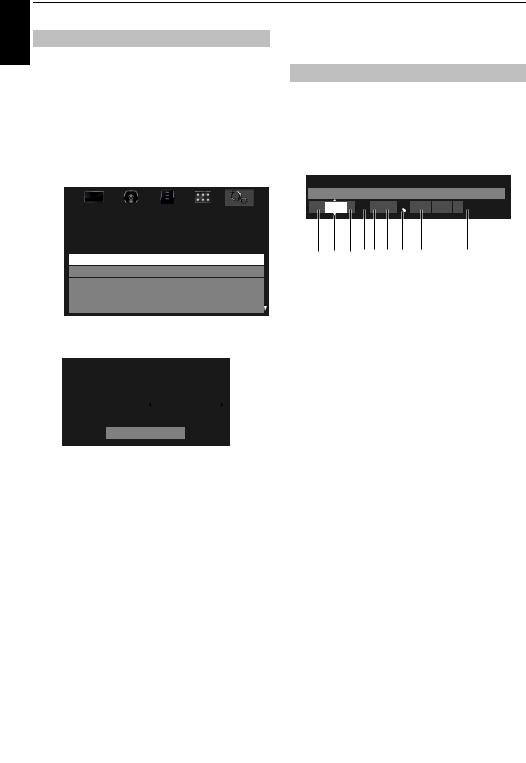
English
SETTING UP YOUR TV
Auto Tuning
NOTE: As new services are broadcast, it will be necessary to re-tune the television in order to view them.
Auto Tuning will completely re-tune the television and can be used to update the channel list. It is recommended that Auto
Tuning is run periodically to ensure that all new services are added. All current channels and settings, i.e. locked channels, will be lost.
a Press MENU / Ccto highlight SETUP icon.
b Press Bor bto select Auto Tuning and press OK.
SETUP
Menu Language |
English |
|
|
Country |
Germany |
|
|
Ant/Cable In |
Antenna |
Auto Tuning
ATV Manual Tuning
DTV Manual Tuning
DTV Settings
Quick Setup
c A screen will appear warning that previous programmes and settings will be deleted.
Auto Tuning
Previous settings will be lost!
Press EXIT for no change.
Tuning Mode |
DTV and ATV |
Start Scan
Press Cor cto select DTV and ATV, DTV or ATV, if available, then highlight Start Scan and press OK to continue with the Auto Tuning.
NOTE: If you have selected “Others” for the Country field in the SETUP menu, and selected a tuning mode other than “DTV” , choose the optimum ATV broadcasting system (B/G, I, D/K or L).
The television will start to search for all available DTV and/or ATV services.
You must allow the television to complete the search.
When the search is complete, the Auto Tuning screen will display the services found.
d Press Bor bto move through the list to select a channel and press OK to view.
ATV Manual Tuning
Tuning
The television can be tuned-in manually using ATV Manual Tuning. For example, you might use the feature if the television cannot be connected to a media recorder/decoder with a SCART lead or when you want to tune-in a station on another System.
Use Cand cto move across the screen and select any of the ATV Manual Tuning options. Then use Bor bto adjust the settings.
ATV Manual Tuning
System
1 I A  C 2
C 2  0 V C R
0 V C R 



1 2 3 4 5 6 7 8 9
1Position
The number to be pressed on the remote control to tune the channel.
2System
Specific to certain areas.
3Colour System
Factory set to Auto, should only be changed if problems are experienced, i.e. NTSC input from external source.
4Skip
Set Skip to On (8) or Off (() for the selected channel. See page 18.
5Signal Class
The channel classification.
6Channel
The channel number on which a station is being broadcast.
7Search
Search up and down for a signal.
8Manual Fine Tuning
Only used if interference/weak signal is experienced. See page 60.
9Station
Station identification. Use the Bband Ccbuttons to enter up to seven characters.
To allocate a position on the television for a decoder and media recorder: turn the decoder on, insert a pre-recorded film in the media recorder, press PLAY and manually tune.
16
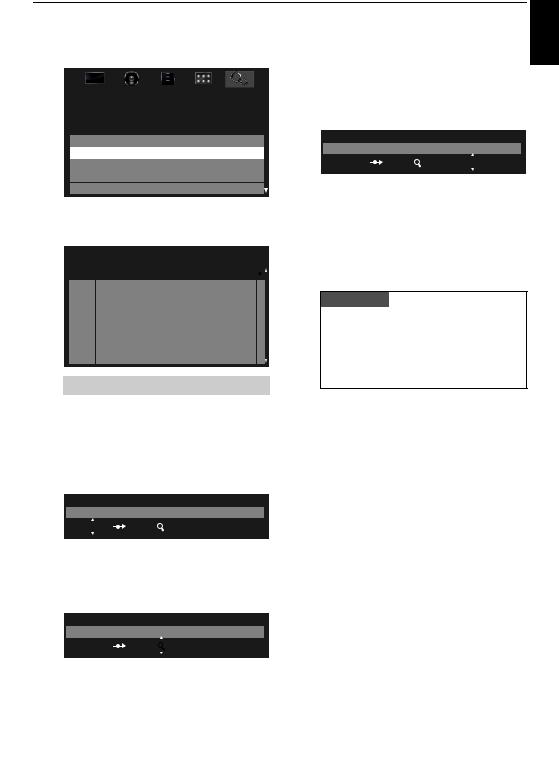
SETTING UP YOUR TV
a In the SETUP menu, press bto select ATV Manual Tuning and press OK.
SETUP
Menu Language |
English |
|
|
Country |
Germany |
|
|
Ant/Cable In |
Antenna |
Auto Tuning
ATV Manual Tuning
DTV Manual Tuning
DTV Settings
Quick Setup
b Use Bor bto select the desired position. We suggest Pos. 0 for a media recorder.
ATV Manual Tuning |
|
|||
|
Pos. |
Channel |
Station |
|
|
|
|
|
|
|
1 |
|
C2 |
|
2S10
3C7
4S40
5C22
6C25
7C28
8C30
Different Channel numbers may be displayed.
c Press OK to select. If the channel chosen for the media recorder is set to skip, Skip should be removed before storing.
g Each signal will show on the television. If it is not your media recorder, press Bor bagain to restart the search.
h When your media recorder signal is found, press cto move along to Station. Use B, b, Cand cto put in the required characters, e.g. VCR.
ATV Manual Tuning
Station
1 |
I |
|
A |
C |
2 |
|
0 |
|
V |
|
C |
|
R |
|
|
|
|
|
|
|
|
i Press OK to save.
j Repeat for each position you want to tune, or press BACK to return to the list of channels and select the next number to tune.
k Press EXIT when you have finished.
PLEASE NOTE
This television has direct channel entry if the channel numbers are known.
Select the ATV Manual Tuning screen in Step 3. Enter the Position number, the System, then C for standard (terrestrial) channels or S for cable channels and the Channel number. Press OK to save.
d Press cto select System and press Bor bto change if required.
ATV Manual Tuning
System
1 |
I |
A |
C |
2 |
|
0 |
|
|
|
|
|
|
|
|
|
|
|
|
|
|
e Then press cto select Search.
f Press Bor bto begin the search. The search symbol will flash.
ATV Manual Tuning
Search
1 |
I |
A |
|
|
C |
2 |
|
0 |
|
|
|
|
|
|
|
|
|
|
|
|
|
English
17
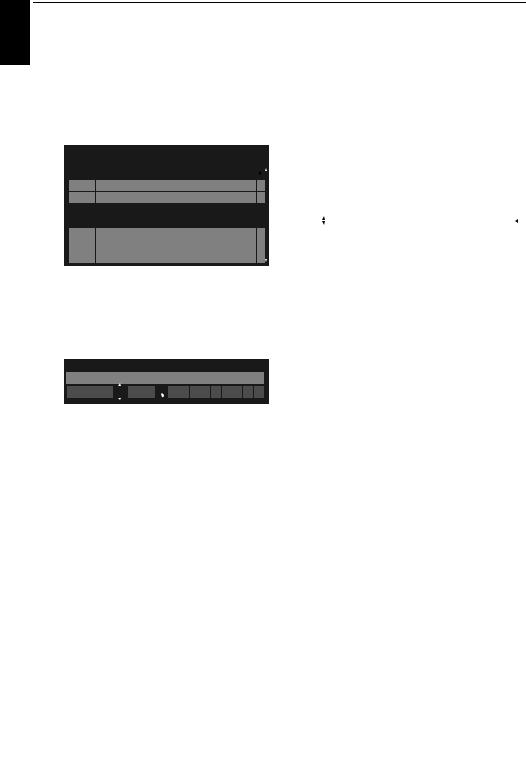
English
SETTING UP YOUR TV
Skip |
|
Sorting positions |
To prevent certain channels from being viewed, positions can be skipped.
a Select ATV Manual Tuning from the SETUP menu.
b Use Bor bto highlight the position to be skipped and press OK to select.
ATV Manual Tuning |
|
|||
|
Pos. |
Channel |
Station |
|
|
1 |
|
C2 |
|
2S10
3C7
4 |
|
S40 |
ABC1 |
|
|
|
|
5 |
|
C22 |
ABC1 |
6C25
7C28
8C30
c Press cto select Skip.
d Use Bor bto turn Skip on. Press OK.
8on the screen indicates a skipped position.
ATV Manual Tuning
Skip: On
1 I A  C 2
C 2  0
0
e Press BACK and repeat from Step 2 or press EXIT.
Channels may be moved and saved to the position of your choice.
a Select ATV Manual Tuning from the SETUP menu.
b With the list of channels showing, use Bor bto highlight the channel you want to move and press c.
ATV Manual Tuning |
|
|
||
|
Pos. |
Channel |
Station |
|
|
2 |
S10 |
|
|
|
3 |
C7 |
|
|
|
4 |
C40 |
ABC1 |
|
|
5 |
C22 |
ABC1 |
|
|
1 |
C2 |
|
|
|
6 |
C25 |
|
|
|
7 |
C28 |
|
|
|
8 |
C30 |
|
|
c Use Bor bto move through the list to your preferred position. As you do so, the other channels will move to make room.
d Press Cto save your move.
Repeat as necessary and press EXIT.
Each position has to be individually selected. To turn Skip off, repeat the procedure for each position.
Skipped positions cannot be selected by PUand Pu or by the controls on the television but can still be accessed by the number buttons on the remote control.
18
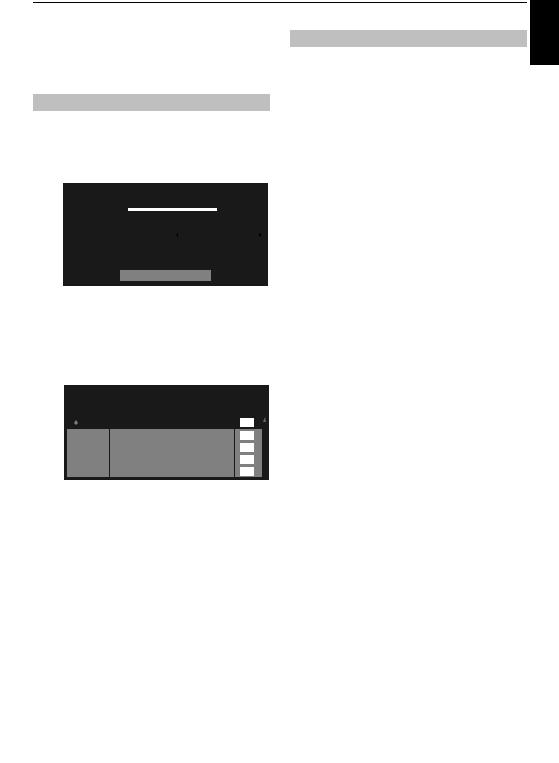
SETTING UP YOUR TV
DTV Manual Tuning
NOTE: This feature varies depending on the Ant/Cable In setting.
Manual Tuning
Manual Tuning for DVB-C
When Ant/Cable In is set to Cable, DTV Manual Tuning items are as follows:
Frequency – input a specific frequency to be scanned
Modulation – choose from one of five QAM modulation options
This feature is available for service engineers or can be used for direct channel entry if the multiplex channel is known.
a Select DTV Manual Tuning from the SETUP menu and press OK.
DTV Manual Tuning - Antenna
Signal Strength |
WEAK |
AVERAGE |
STRONG |
||
|
|
|
|
|
|
Quality |
GOOD |
|
|
|
|
|
|
|
|
|
|
Channel |
|
|
|
13 |
|
|
|
|
|
|
|
Frequency |
|
|
|
506.0MHz |
|
|
|
|
|
|
|
Bandwidth |
|
|
|
8MHz |
|
Start Scan
b Enter the multiplex number using the number buttons or use Cor cto adjust the number up or down.
c Highlight Start Scan and press OK. The television will automatically search for that multiplex.
DTV Manual Tuning - Antenna |
|
|
|
|
|||
|
|
|
0 New Channels - Total 6 |
|
|
|
|
New Pos. |
Name |
|
Type |
||||
|
1 |
|
ABC ONE |
|
|
|
|
2 ABC TWO
7 ABC THREE
40 ABC NEWS 24
51 ABCi
When the multiplex is found, any channels that are not currently in the channel list will be added and the channel information at the top of the screen will be updated.
d Repeat as necessary. Press EXIT to finish.
Symbol Rate – input a specific baud rate (KS/s) to be used for the manual scan
English
19
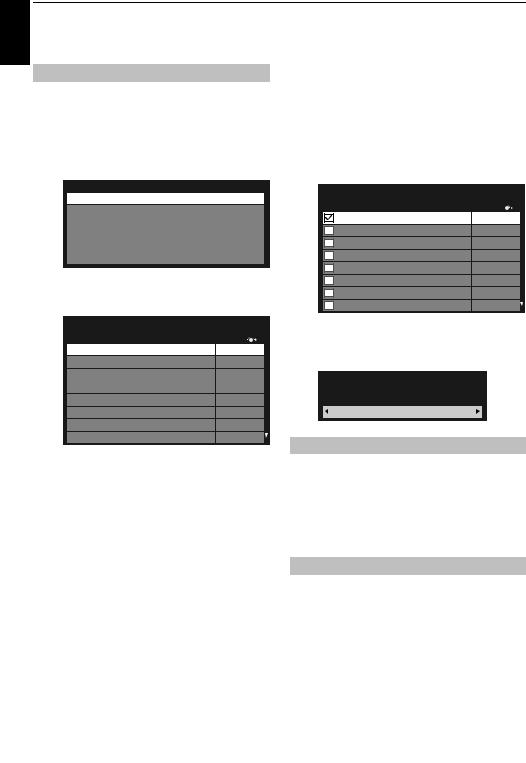
English
SETTING UP YOUR TV
DTV Settings
Channels
The channel order may be changed to suit your personal preference.
a Select DTV Settings from the SETUP menu and press
OK.
b Select Channels and press OK.
Move — Press the GREEN button to activate the Move feature. Press the Bor bbuttons to select the channel you wish to move and press OK to check.
If you wish to move multiple channels at once, select another channel and check in the same way. Repeat as necessary.
Once all desired channels have been checked, press the Bor bbuttons to place the focus at the position to which you wish to move the channels. The channels will be inserted above the highlighted channel. Press the GREEN button to execute the move.
DTV Settings |
Channels |
|
|
|
|
Channels |
Line No. 1/10 |
|
Subtitle and Audio |
Pos. |
Name |
|
|
|
Parental PIN Setup |
1 |
ABC ONE |
|
|
|
Parental Control |
2 |
ABC TWO |
|
|
|
Local Time Setting |
7 |
ABC THREE |
|
|
|
Common Interface |
30 |
CABC Channel |
|
|
|
40 |
ABC NEWS 24 |
c |
51 |
ABCi |
For your convenience, you can jump to specific places |
AA |
|
|
822 |
|
|
in the list by one of two methods. |
|
|
823 |
AC |
Channels
Line No. 1/10
Pos. Name
1 ABC ONE
2 ABC TWO
7 ABC THREE
30 CABC Channel
40 ABC NEWS 24
51 ABCi
822 AA
823 AC
Line Number Jump — Use the number buttons
(0-9) to input the line number you want to select and press OK.
Name Jump — Press CCor ccto jump to the next station name with a different initial letter.
It is also possible to change the Position number of a particular channel.
Renumber — Press the RED button to renumber the highlighted channel. Edit the channel number using the number buttons and press OK. If the position number you input already exists, a confirmation window will appear.
|
|
Pos. |
Name |
|||
|
- |
- |
- |
- |
ABC ONE |
|
|
|
|
|
|
|
|
Position No. Sort — Press the YELLOW button. A confirmation window will appear. Press Cor cto select Yes and press OK.
Your existing channel order will be lost.
Do you wish to continue?
Yes
Location setting
You can select either Home or Store mode. Home is recommended for normal home use. Select Store when using the television for displaying in a shop, etc.
a Select Location from the SETUP menu.
b Press Cor cto select Home or Store.
Analogue switch-off
This is a digital television which is integrated to allow the use of both digital and analogue services. However, during the lifetime of this set it is very likely that analogue services will be switched off to allow for more new digital services.
This ‘switch-off’ will happen in a number of phases, which will be advertised in your area well in advance. It is recommended that at each phase the television is re-tuned to ensure that existing and new digital services can be viewed without disruption.
20

CONTROLS AND FEATURES
General controls
Quick Menu
Quick Menu helps you access some options quickly, such as
Picture Mode, Picture Size, More Information, Sleep Timer etc.
Press QUICK to display the Quick Menu and use Bor bto select the option.
Quick Menu
Picture Mode |
|
AutoView |
|
|||
Picture Size |
|
Super Live |
|
|||
3D Settings |
|
|
|
|
|
|
More Information |
|
|
|
|
|
|
Channel Options |
|
|
|
|
|
|
Toshiba Places |
|
|
|
|
|
|
|
|
|
|
|
|
|
YouTube |
|
|
|
|
|
|
USB Media Player |
|
|
|
|
|
|
Network Media Player |
|
|
|
|
|
|
Sleep Timer |
00:00 |
|
|
|||
Headphone Level |
50 |
|
|
|
|
|
|
|
|
|
|
||
Wireless Information |
|
|
|
|
|
|
NOTE: Quick Menu items are different depending on the current mode.
Quick menu item example
Mode |
Quick menu item |
Description |
|
When viewing a TV |
Picture Mode |
See page 30. |
|
programme or |
|
|
|
Picture Size |
See page 28. |
||
pictures from the |
|||
|
|
||
3D Settings |
See page 23. |
||
external input |
|||
Single Window or |
More Information |
See page 49. |
|
|
|
||
Channel Options |
See page 52. |
||
3D Single Window |
|||
|
Toshiba Places |
See page 38. |
|
|
YouTube |
See page 39. |
|
|
|
|
|
|
USB Media Player |
See page 40. |
|
|
|
|
|
|
Network Media |
See page 41. |
|
|
Player |
|
|
|
Sleep Timer |
See page 48. |
|
|
|
|
|
|
Headphone Level |
See page 27. |
|
|
Wireless Information |
See page 35. |
|
|
|
|
|
When using EPG |
Genre Colour |
See page 50. |
|
|
|
|
|
|
EPG Update/ |
See page 50. |
|
|
Cancel EPG Update |
|
Mode |
Quick menu item |
Description |
|
USB Media Player |
PICTURE |
See page 30. |
|
(Photo Single View, |
|
|
|
SOUND |
See page 26 |
||
Slide Show) |
|||
Interval Time |
See page 42. |
||
|
|||
|
|
|
|
|
Repeat |
See page 42. |
|
|
|
|
|
|
Background Music |
See page 42. |
|
|
Play List |
See page 42. |
|
|
|
|
|
|
Sleep Timer |
See page 48. |
|
|
|
|
|
|
Headphone Level |
See page 27. |
Selecting channels
To select a channel, use the numbered buttons on the remote control.
Channels can also be selected using PUand Pu.
To display on-screen information such as channel, input mode or stereo/mono signal, press  . Press again to cancel.
. Press again to cancel.
The Time Display – analogue only
The time display facility allows the current (text service) time to be seen on the television screen.
Press Dwhilst watching a normal television broadcast to see the time display from the broadcaster. It will remain on screen for about 5 seconds.
NOTE: This display may not be available in some cases.
Stereo and Bilingual transmissions
For DTV programmes
For stereo or dual mono broadcasts, press sand use Cor cto select settings.
Mode Display |
Pressing c |
Stereo |
Stereo SLeft SRight |
|
|
Dual mono |
Dual 1 SDual 2 SDual |
|
|
Mono |
– |
|
|
Multichannel |
– |
|
|
For multi-audio track broadcasts, press srepeatedly to change the audio language (see “Audio languages” on page 53).
For ATV programmes
If stereo or dual language broadcasts are transmitted, the word Stereo or Dual will appear on the screen each time channels are changed, disappearing after a few seconds. If the broadcast is not in stereo, the word Mono will appear.
Stereo… Press sto select Stereo or Mono.
Bilingual… Bilingual transmissions are rare. If they are transmitted, the word Dual will be displayed. Choose the required programme number, and if the word Dual appears, press sto select Dual 1, Dual 2 or Mono.
English
21
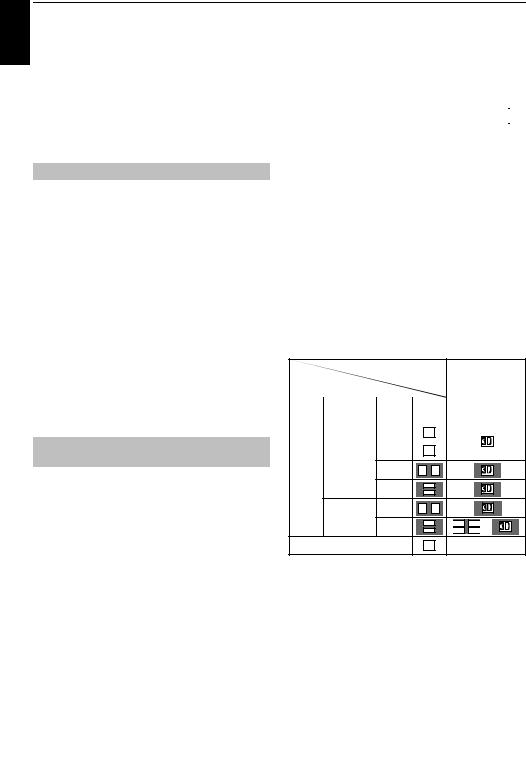
English
CONTROLS AND FEATURES
Using 3D functions 3D format select:
If a right and left images are same in Native mode, select SBS.
Before using 3D programming, see and follow “When using the 3D glasses” section on page 6.
Viewing 3D programming requires the following:
•TOSHIBA 3D Glasses (not supplied)
•Compatible 3D playback device or 3D source
•3D capable high quality HDMI cable
Viewing 3D images
Incoming video signals can either be in 2D or 3D format. A 2D signal can only be viewed as 2D, but 3D can be viewed in either 2D or 3D. If the TV can detect the fact that a signal is 3D, it can change to 3D mode automatically – see “Setting the auto start mode” (on page 24). Otherwise the user can change the viewing mode using the 3D button. Finally, the format of the 3D signal can be either Side by Side (SBS) or Top and Bottom (TB). You may
have to choose the correct format if the TV can not detect it automatically – see “Switching display mode or selecting 3D format”, below.
NOTE:
•When 3D format signal is not received, display mode is not switched to 3D.
•The 3D button is available in digital channels or HDMI input.
•If appropriate mode and format are not selected, 3D image is not correctly displayed.
•There will be restrictions on the Picture Size settings for 3D Mode and 2D Mode.
•There are individual differences in perception of 3D images.
•When viewing 3D images, wear the 3D Glasses.
Switching display mode or selecting 3D format
There are three modes for watching TV.
Mode |
Description |
3D |
Displays 3D images. |
|
|
2D |
Changes 3D images to 2D. |
|
|
Native |
Displays a received signal format as it is. |
|
|
If a top and bottom images are same in Native mode, select TB. 3D formats are the following.
3D format |
Description |
||||
Side by |
Images for the left and right eyes |
|
|
|
|
|
|
|
|||
Side (SBS) |
are positioned side-by-side. |
|
|
|
|
|
|
|
|||
|
|
|
|
|
|
Top and |
Images for the left and right eyes |
||||
Bottom |
are positioned at the top and |
|
|
|
|
(TB) |
bottom of the screen. |
|
|
|
|
|
|
|
|||
|
|
|
|
|
|
Frame |
Image for the left and right eyes for |
|
|
|
|
|
|
|
|
||
Packing |
two frames are positioned at the |
|
|
|
|
(FP) * |
top and bottom of the screen. |
|
|
|
|
|
|
|
|
|
|
* This format cannot be selected manually.
The 3D button’s operation:
The behaviour of 3D when viewing in Native mode is different depending on the input mode.
Depending on the input mode, the screen for selecting 2D or 3D is displayed or the display mode switches between 2D and 3D.
To switch to 3D mode:
•Set PREFERENCES / 3D Setup / 3D Auto Start to 3D.
•Press 3D while viewing 2D mode or Native mode.
|
|
|
|
|
|
|
Press 3D button |
||||
Type |
Additional |
Format Source |
|
|
|
|
|
||||
|
Information |
Signal |
|
|
|
|
|
||||
3D |
With 3D |
|
|
|
|
|
|
|
|
|
|
|
|
3D |
|
|
* |
|
|
|
|
||
Format |
Auto Detect |
FP |
|
|
|
|
|
|
|
|
|
Signal |
Information |
|
|
3D |
|
|
|
|
|
|
|
|
SBS |
3D 3D |
* |
|
|
|
|||
|
TB |
3D |
* |
|
|
3D |
|
||
Without 3D |
SBS |
3D 3D |
* |
|
|
||||
Auto Detect |
TB |
3D |
D 3 ** |
|
Information |
||||
3D |
D 3 |
2D Format Signal |
|
3D |
|
|
D |
3 |
|
|
|
|
|
|
|
* Correct 3D image
**When the 3D Format Select is in 3D (TB) mode (see page 23).
22
